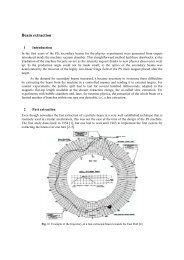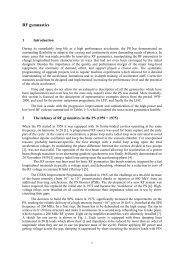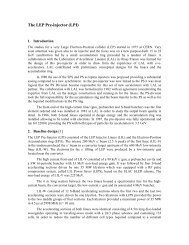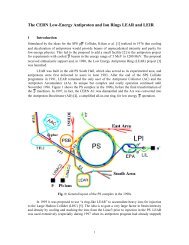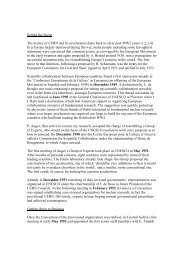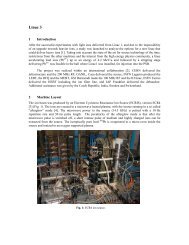Beam extraction - 50th anniversary of the CERN Proton Synchrotron
Beam extraction - 50th anniversary of the CERN Proton Synchrotron
Beam extraction - 50th anniversary of the CERN Proton Synchrotron
Create successful ePaper yourself
Turn your PDF publications into a flip-book with our unique Google optimized e-Paper software.
Fig. 24: Evolution <strong>of</strong> <strong>the</strong> beam distribution during resonance crossing. The initial state is represented<br />
by a bi-Gaussian beam (left), at resonance crossing some particles are trapped inside <strong>the</strong> moving<br />
islands (centre), at <strong>the</strong> end <strong>of</strong> <strong>the</strong> process, <strong>the</strong> particles trapped in <strong>the</strong> islands are moved towards higher<br />
amplitudes (right).<br />
When <strong>the</strong> tune is changed, <strong>the</strong> islands move through <strong>the</strong> phase space region where <strong>the</strong> charged<br />
particles sit and some are trapped inside <strong>the</strong> islands. At some stage a complete separation between <strong>the</strong><br />
beamlets and <strong>the</strong> central core occurs and <strong>the</strong> distance between <strong>the</strong> beamlets can be increased at will by<br />
simply acting on <strong>the</strong> tune. It is worth while stressing that <strong>the</strong> beam after trapping has a peculiar structure,<br />
i.e., it is made <strong>of</strong> two disconnected parts: <strong>the</strong> beamlets, which are indeed one single structure closing up<br />
after four turns around <strong>the</strong> machine (see Fig. 25), and <strong>the</strong> central core.<br />
The idea behind this process is that such a beam splitting in <strong>the</strong> transverse phase space can be used<br />
to perform multi-turn <strong>extraction</strong>. In fact, once <strong>the</strong> various beamlets are separated, <strong>the</strong> whole structure can<br />
be pushed towards an <strong>extraction</strong> septum by means <strong>of</strong> a closed slow bump. Then, kicker magnets generate<br />
a fast closed bump and one island jumps beyond <strong>the</strong> septum blade so that <strong>the</strong> beamlets are extracted out<br />
<strong>of</strong> <strong>the</strong> machine in four turns. The fifth beamlet, i.e., <strong>the</strong> beam core, is extracted using a classical singleturn<br />
<strong>extraction</strong>. The advantage <strong>of</strong> this approach is that, at least for <strong>the</strong> first four turns, <strong>the</strong> optical<br />
parameters are, by definition, <strong>the</strong> same. This is intrinsic to <strong>the</strong> method, as <strong>the</strong> same stable island is used to<br />
extract <strong>the</strong> beam.<br />
It is worth stressing that numerical simulations are performed by crossing <strong>the</strong> resonance from<br />
above: this is <strong>the</strong> opposite <strong>of</strong> what is done in <strong>the</strong> experimental tests, where <strong>the</strong> resonance is crossed from<br />
below. The choice <strong>of</strong> <strong>the</strong> resonance to be crossed is completely arbitrary as <strong>the</strong> use <strong>of</strong> a fourth-order<br />
resonance is dictated only by <strong>the</strong> <strong>CERN</strong>-specific application (see Refs. [37, 38] for a generalization to<br />
o<strong>the</strong>r types <strong>of</strong> resonance and to injection, respectively).<br />
6.2 Measurement results<br />
6.2.1 Overall measurement strategy<br />
In parallel with <strong>the</strong> computational and <strong>the</strong>oretical analysis, an intense experimental campaign was<br />
launched at <strong>the</strong> end <strong>of</strong> 2001 on <strong>the</strong> <strong>CERN</strong> PS (see Ref. [39] for <strong>the</strong> final account <strong>of</strong> <strong>the</strong> results achieved).<br />
This entailed <strong>the</strong> development <strong>of</strong> new measurement systems, such as <strong>the</strong> turn-by-turn orbit measurement<br />
system [40, 41], as well as <strong>the</strong> installation <strong>of</strong> sextupoles and octupoles to generate <strong>the</strong> stable islands.<br />
20



